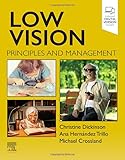Low vision : principles and management / Christine Dickinson, Ana Hernández Trillo, Michael D. Crossland.
Material type: TextPublication details: [Amsterdam]: Elsevier, c2024.Description: ix, 331 pages : illustrations ; 28 cmISBN:
TextPublication details: [Amsterdam]: Elsevier, c2024.Description: ix, 331 pages : illustrations ; 28 cmISBN: - 9780323876346
- 032387634X
- RE91.D53 2024
| Item type | Current library | Call number | Status | Date due | Barcode | |
|---|---|---|---|---|---|---|
 Books
Books
|
KMTC:NAIROBI CAMPUS Reference | RE91.D53 2024 (Browse shelf(Opens below)) | Not For Loan | 31539 |
"Enhanced digital version included."--Front cover.
Includes bibliographical references.
CONTENTS
PART 1. Defining Low Vision:
1. What Is Low Vision? -
2. Prevalence and Causes of Low Vision -
3. Clinical Measures of Visual Performance -
4. Patient Centred Outcome Measures
PART 2. Magnification as a Strategy for Improving Visual Performance:
5. Magnification -
6. Relative Size Magnification: Increasing the Object Size -
7. Relative Distance Magnification: Decreasing the Viewing Distance -
8. Transverse Magnification -
9. Angular Magnification
PART 3. Other Methods for Visual Rehabilitation:
10. Contrast and Glare -
11. Illumination and Lighting -
12. Aids for Peripheral Field Loss -
13. Special Training Techniques for Visual Field Loss -
14. Rehabilitation Techniques for Nystagmus -
15. Sensory Substitution -
16. Inclusive and Universal Design.
PART 4. Clinical Procedures:
17. The Low Vision Assessment -
18. The Eye Examination -
19. Prescribing Magnification -
20. Instruction and Training in the Use of Magnifiers -
21. Evaluating Low Vision Services -
22. The Place of Low Vision in Optometric Practice -
23. Case Studies
PART 5. Appendices:
Appendix 1. Useful Information
Appendix 2. Sample Record Sheets
Appendix 3. Patient Literature
Appendix 4. Examples of Clinic Letters
Providing an ideal balance of theory and practice, Low Vision: Principles and Management covers all aspects of providing effective eye care to individuals with visual impairment. This concise yet comprehensive resource covers everything from theoretical background to current rehabilitative aids and low vision treatment strategies-all while adopting a practical approach to vision care. It brings practising eye care professionals and students fully up to date with current optical and electronic devices and how they are used in everyday practice, as well as evidence-based vision rehabilitation guidelines. Features comprehensive guidance on visual rehabilitation for acuity loss and visual field loss. Describes a wealth of practical advice and real-world case scenarios to help guide your day-to-day patient interactions as well as your most challenging situations. Covers hot topics, including the link between mental health and low vision, assistive technologies, measures of quality of life and other outcome measures, WHO classifications of visual impairment, and best practices for auditing and commissioning vision services. Contains over 200 diagrams, illustrations, and patient photos to aid in visual understanding. Explains how eye care professionals can work within a multi-disciplinary team to provide complete care. An eBook version is included with purchase. The eBook allows you to access all of the text, figures and references, with the ability to search, customize your content, make notes and highlights, and have content read aloud.
There are no comments on this title.

